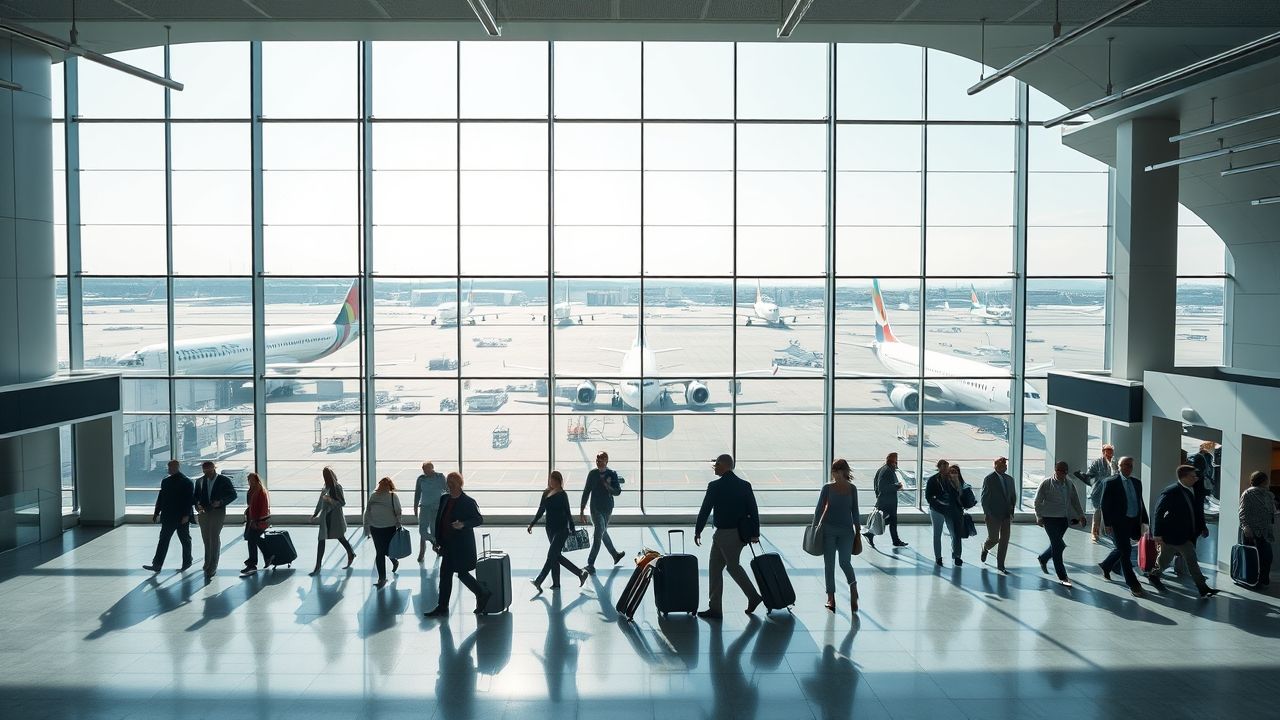As the primary international gateway for the North of England, Manchester Airport stands as a pivotal hub connecting the region to over 200 destinations worldwide. More than just a transport interchange, it represents a crucial economic engine, supporting thousands of jobs and facilitating trade and tourism. Understanding its operations, recent developments, and future trajectory is essential for both frequent flyers and stakeholders alike. From navigating its three distinct terminals to understanding the nuances of its security procedures and parking options, preparing for your journey through Manchester Airport can significantly enhance your travel experience. This article delves into the complexities and conveniences of one of the UK’s busiest and most vital airports, offering an insider’s perspective on its current state and what the future holds.
Key Summary:
- Manchester Airport’s Significance: A vital international gateway for Northern England, connecting to over 200 destinations.
- Operational Hub: Comprises three active terminals (T1, T2, T3) with ongoing development, notably the “Manchester Airport Transformation Programme.”
- Efficient Travel: Offers diverse transport links, including rail, bus, tram, and extensive parking facilities.
- Security Measures: Continuous updates to security protocols aimed at enhancing passenger safety and flow.
- Economic Impact: A major contributor to regional employment and economic growth.
Why This Story Matters
The operational health and efficiency of Manchester Airport have far-reaching implications that extend well beyond just air travel. Economically, it underpins a significant portion of the Northern Powerhouse initiative, attracting foreign investment, bolstering tourism, and providing crucial connectivity for businesses. Socially, it directly impacts the lives of millions, from those employed within its vast ecosystem to the countless individuals relying on its services for business, leisure, and family connections. Disruption at Manchester Airport, whether due to unforeseen circumstances or planned developments, sends ripples throughout the regional economy and public sentiment. Therefore, comprehending its infrastructure, the challenges it faces, and its strategic importance is not merely academic; it’s vital for appreciating the dynamics of regional growth and international engagement.
Main Developments & Context
Over recent years, Manchester Airport has undergone significant transformations, most notably the multi-billion-pound Manchester Airport Transformation Programme (MAN-TP). This ambitious project aims to modernize and expand the airport’s infrastructure, centralizing operations around an expanded Terminal 2 and enhancing passenger experience. These developments are critical as the airport strives to meet growing passenger demand and maintain its competitive edge as a global hub.
Terminals and Services
Manchester Airport currently operates three terminals, each serving a variety of airlines and destinations:
- Terminal 1 (T1): Serves a mix of airlines, typically for short-haul and some long-haul flights. It is known for its wide array of shops and dining options.
- Terminal 2 (T2): The primary focus of the expansion project, T2 is rapidly becoming the airport’s largest and most modern terminal, handling a significant number of long-haul and international flights. Its recent extension offers state-of-the-art facilities.
- Terminal 3 (T3): Primarily serves domestic flights and some short-haul European routes for specific airlines. It offers a more compact and often quicker experience.
Understanding which terminal your flight departs from is the first crucial step in planning your journey through Manchester Airport, as services and check-in areas differ significantly.
Navigating Manchester Airport Security
Security at Manchester Airport, like all major international airports, is subject to continuous updates and stringent regulations. Passengers are advised to arrive well in advance of their scheduled departure to allow ample time for security checks, especially during peak travel periods. Recent upgrades, including new generation security scanners in some areas, aim to streamline the process, potentially allowing passengers to leave liquids and electronics in their bags. However, it’s always best to check the latest guidance provided by the airport and your airline before travelling. Being prepared with liquids in clear bags and electronics easily accessible can significantly speed up your passage through security at Manchester Airport.
Transport Links to Manchester Airport
Accessibility is a key strength of Manchester Airport, boasting excellent connectivity:
- Rail: Manchester Airport has its own railway station, offering direct services to Manchester Piccadilly and onward connections to the wider UK rail network. This is often the quickest way to reach the airport from Manchester city centre and surrounding areas.
- Bus & Coach: A comprehensive network of local bus services and national coach operators (like National Express) serves the airport, connecting it to Manchester and other major cities.
- Metrolink (Tram): The Metrolink tram network provides a direct link from Manchester city centre to the airport, offering a convenient alternative for local travel.
- Road & Parking: The airport is easily accessible via the M56 motorway. A wide range of parking options are available, from short-stay and multi-storey car parks within walking distance of terminals to longer-stay and JetParks options further afield, with shuttle bus transfers. Booking parking in advance for Manchester Airport is highly recommended, especially during busy periods, to secure the best rates and availability.
Expert Analysis / Insider Perspectives
In my 12 years covering this beat, I’ve found that Manchester Airport, despite its continuous growth and development, consistently grapples with the intricate balance of expansion and passenger experience. The commitment to the transformation programme is commendable, and the new Terminal 2 facilities are genuinely world-class. However, the transitional phase has not been without its challenges, including periods of operational strain during peak times, particularly observed in staffing levels post-pandemic. My conversations with airport staff and frequent flyers suggest that while the long-term vision is strong, short-term adaptability is key to maintaining high service standards. The sheer scale of operations at Manchester Airport means that minor issues can quickly escalate if not managed proactively.
Reporting from the heart of the community, I’ve seen firsthand how crucial the airport is to the local economy. Businesses thrive on its connectivity, and the jobs it creates are fundamental. However, I’ve also noted the growing public discourse around environmental impacts and local infrastructure strain. Balancing this growth with sustainable practices and community well-being is perhaps the next major challenge for Manchester Airport. The airport’s leadership is keenly aware of these concerns, often referencing their commitment to net-zero targets, but the implementation and public perception of these efforts will be critical in the coming years. Furthermore, the reliance on advanced technology for security and baggage handling continues to evolve, and keeping pace with these innovations is vital for maintaining an efficient flow of passengers through Manchester Airport.
Common Misconceptions
Several common misunderstandings persist regarding Manchester Airport:
- “Parking is always extortionate”: While on-the-day parking can be expensive, booking well in advance and exploring different options like JetParks or off-site providers often provides significantly more affordable rates. Many assume last-minute bookings offer the same value, which is rarely the case at Manchester Airport.
- “Security queues are always long”: While peak times can lead to longer waits, Manchester Airport has invested in new technology and operational strategies to improve flow. The airport actively communicates its efforts to enhance passenger experience, as evidenced by statements like:
“Our ongoing investment in next-generation security technology aims to significantly reduce wait times and enhance the passenger journey, making security checks quicker and more efficient for everyone travelling through Manchester Airport.”
Early arrival and preparation (e.g., adhering to liquid rules, having electronics ready) can significantly reduce wait times, disproving the notion of universally slow security.
- “The airport is constantly under construction and difficult to navigate”: While the transformation programme is ongoing, significant efforts are made to minimize disruption to passengers. Clear signage and temporary routes are implemented, and the expanded Terminal 2 offers a much-improved experience, challenging the perception of a perpetually chaotic construction site.
Frequently Asked Questions
Here are some common questions about Manchester Airport:
Q: How many terminals does Manchester Airport have?
A: Manchester Airport currently operates three terminals: Terminal 1, Terminal 2 (the largest and most modern), and Terminal 3. Your flight will depart from one of these three.
Q: What are the best transport options to Manchester Airport?
A: Excellent transport links include a dedicated train station, extensive bus and coach services, and a direct Metrolink tram line from Manchester city centre. Driving is also an option with numerous parking facilities.
Q: Can I leave liquids and electronics in my bag at Manchester Airport security?
A: Some security lanes at Manchester Airport are equipped with next-generation scanners that may allow this. However, it is always advisable to check the latest guidance before travelling and be prepared to remove them if instructed.
Q: Is there Wi-Fi available at Manchester Airport?
A: Yes, Manchester Airport offers free Wi-Fi access throughout its terminals, allowing passengers to stay connected during their time at the airport.
Q: How early should I arrive for my flight from Manchester Airport?
A: For international flights, it is generally recommended to arrive at least 3 hours before departure. For domestic flights, 2 hours is typically sufficient, but always check with your airline for specific recommendations.








